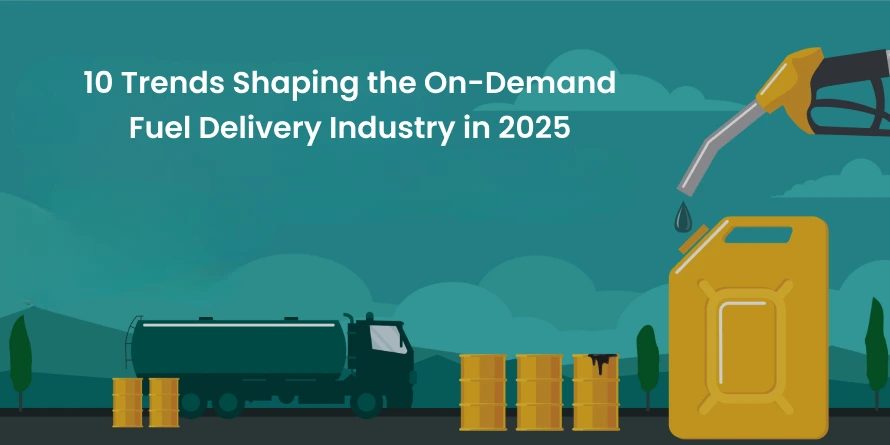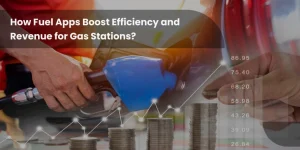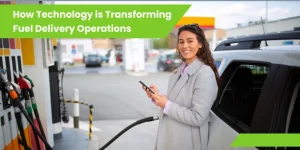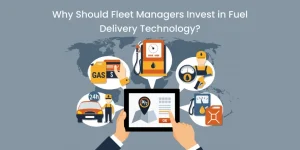10 Fuel Delivery Trends You Must Know for 2025

The on-demand fuel delivery has experienced a significant revolution in the modern world due to technology, customer needs and demands, and environmental considerations. The concept that used to be a luxury novelty is gradually turning into an essential tool, or rather a necessity for people, companies, and even owners of electric cars.
Since convenience is one of the most essential factors in today’s busy world, the demand for fuel at one’s doorstep, office, or even in a parked car has become a game-changer. This transition is not only reshaping how energy is supplied for vehicles but also introducing innovative services and delivery methods that are set to redefine the entire market. The on-demand fuel delivery revolution is playing a key role in enhancing accessibility and efficiency.
When looking towards the future of the on-demand fuel sector through 2025 and beyond, several significant trends are set to define this market. They will not only improve the consumer experience but will also help drive the energy transition for a brighter, cleaner, and leaner system. With such dynamics in place, it becomes evident that the manner in which automobiles are being powered is undergoing a revolution in the industry.
On-demand Fuel Delivery Market Size
The on-demand fuel delivery is a product that has started to gain momentum in the market as a convenient and efficient method of delivering fuel to various In the past, the process of ordering fuel was to go physically to a station or order fuel on the schedule by arrangement. However, this has rapidly changed significantly with the introduction of on-demand fuel delivery services, which has made the whole process more flexible.
So, for those aspiring entrepreneurs who want to start a fuel delivery business, this is the best time to get started. Through innovation and learning the requirements of the consumer, companies can take advantage of the tendency and create a service that is becoming crucial in today’s world.
The global on-demand fuel delivery market will grow at a CAGR of 7.1% over the forecast period. The market is estimated to be valued at USD 5,064.1 Million in 2023, while it is projected to reach USD 10,086.4 Million by the end of 2033.
| Attributes | Details |
|---|---|
| Mobile Fuel Delivery Market (2023-2033) | 7.1% |
| Mobile Fuel Delivery Market Size (2023) | USD 5,064.1 million |
| On-demand Fuel Delivery Market Size (2033) | USD 10,086.4 million |
The growing demand for gas and oil due to urbanization, population growth, and industrialization is increasing the market size. An alluring substitute for conventional fuel delivery/stations, which are not only more costly but also need more time, are mobile fuel delivery systems.
Customers can refuel their cars conveniently without going to a gas station by using on-demand fuel delivery services. Customers can use online platforms or fuel delivery mobile apps to order fuel, indicating their location and preferred fuel quantity.
By tapping into fuel delivery app development that provides easy booking, safe payment methods, and real-time tracking of fuel delivery vehicles, entrepreneurs in this segment can capitalize on this opportunity. By offering on-time and reliable fuel delivery services, businesses can cater to the evolving needs of modern customers, offering them comfortable alternatives to conventional fueling methods.
Top 10 On-demand Fuel Delivery Trends that Drove 2025 & Beyond

This industry of on-demand fuel delivery is growing fast as new trends define the operations of companies and the consumers’ approach to the service.
As such, it is imperative for ‘new kids on the block’ to identify the trends that will shape the future in order to make appropriate preparations to satisfy the increasing need that is now associated with convenience, sustainability, and innovation.
Following are some of the prominent trends that will significantly affect the future of the fuel delivery industry.
Accelerating Forecourt Experiences
This is by far the largest wager that a lot of gasoline companies are making on their marketing and business plans. Since the COVID-19 outbreak, forecourts have been recognized as more than just petrol stations. Gasoline sellers must see them as convenience stores that sell fuel and related goods.
In order to modernize client involvement, fuel retailers may attempt to outperform rivals by creating a pleasant atmosphere at pumps with cozy seating, parking areas, electric vehicle charging stations, and convenience stores with a variety of goods.
According to a recent KPMG study on the experience of forecourts, “it is anticipated that the forecourt market will reach $274 billion by 2029.” Therefore, gas stations that do not stock non-fuel retail items may have to face tough competition in the years to come.
Sustainability and Green Fuel
Now, sustainability development is not just a trend or a mere topic for discussion, but it’s a core goal of consumers, business entities, and governments. As there is a heightened awareness of environmental degradation, there are significant calls for eco-friendly fuels like biofuels, renewable diesel, and hydrogen.
These on-demand fuel delivery businesses start partnering up with these kinds of fuel as they open up the source for these consumers to achieve lower emissions while maintaining services.
As the market of omnichannel delivery of fuel to consumers is emerging, entrepreneurs have to think about how sustainable fuel could be incorporated into their business strategies. Making green fuel options is not only a response to global trends but also an advantage when it comes to customers who care about the environment.
Mobile App and Platform Advancements
It has gotten to the point where the mobile application is an essential component of revolutionizing numerous industries, including fuel delivery. Consumers today are more demanding, and they want the fastest deliveries, which are smooth and easy in terms of interfacing with digital devices. Such businesses in fuel delivery cannot afford to ignore this factor.
Recent developments are already beginning to introduce real-time tracking, optimal delivery schedules, and almost immediate payments, allowing customers to have more control over their fueling requirements. For anyone hoping to succeed in this highly competitive fuel delivery service, it is vital to build applications that are as seamless as possible.
End-to-end Digitization Route
The fuel delivery sector is evolving, and all are set to implement complete digitization, from order placement to order tracking to making payments. By going fully digital, companies can achieve better efficiency, streamline operations, and enhance customer transparency. This digital transformation allows enterprises to automate essential functions such as inventory management, route predictions, and customer service, which eventually leads to better and more trusted deliveries.
Moreover, entrepreneurs should also make decent investments in digital infrastructure that integrate all facets of their operations. Integrating cloud-based applications and software and modern machine learning algorithms can also help predict customer behavior, and ensure hassle-free operations for all the stakeholders involved. Ultimately, executing digital practices not only reduces operational bottlenecks but also offers important insights to help companies make informed decisions.
IoT Sensors
The IoT will revolutionize the fuel delivery industry by enabling and enhancing the transparency of real-time data and insights designed to improve efficiency and safety. IoT sensors embedded in fuel tanks and delivery vehicles can monitor fuel levels, detect leaks, track deliveries, and even predict equipment failure. Visibility at this level will help businesses efficiently control their inventory, reduce wasted fuel, and be quicker than ever to meet customer needs.
For entrepreneurs, including IoT sensors in the fuel delivery process is an investment in efficiency and customer satisfaction. Monitoring ensures accurate schedules for fuel delivery and minimizes disruptions, leading to better services and improved customer retention. Also, IoT data can be used to optimize routes and predict when maintenance or refueling is needed to minimize downtime and enhance fleet management.
Autonomous Cars and Drones
Autonomous cars and drones will be a game changer for the on-demand fuel delivery industry. The delivery of small amounts of fuel through drones will become much faster and more efficient as they will have access to otherwise unreachable places and also in heavily populated cities. The autonomous truck is going to minimize the need for human labor, use more fuel efficiently, and reduce delivery times.
Autonomous technology should be a part of an entrepreneur’s business model, given the growing competition. Indeed, fully autonomous fuel delivery is still some way off, but pilot programs for such technologies can create a differentiator and help open doors to future growth.
Cost savings and swift delivery are two important aspects that would result from automation in fuel delivery.
AI for Predictive Fueling
AI is revamping the future of fuel delivery and fleet management with predictive analysis. With the help of real-time data, AI algorithms can help fuel companies manage operations efficiently. Some of its benefits include consumer behavior, vehicle usage patterns, consumer fuel prediction, and innovative delivery routes.
This approach allows for more efficient resource allocation and thus improves the customer experience.
Take Your Fuel Delivery to the Next Level
Use AI to make fuel delivery smarter and faster. Contact us to find the best solution for your business!
Environmental Sustainability
With the environmental consciousness increasing amongst businesses and consumers, sustainable practices will be required in the delivery of fuels. Ecological sustainability will be at the center of future business success, from reducing emissions in delivery vehicles to providing alternative fuel sources. Businesses adopting green practices, like using electric vehicles for deliveries or offering carbon offset programs, will attract environmentally-savvy consumers.
For entrepreneurs, the call to environmental sustainability is a question not only of morality but also of strategy. From using cleaner vehicles and more efficient forms of energy to renewing fuels, sustainability is set to become the keystone of long-term business survival.
Customer Loyalty is Taking Center Stage
In a market ruled by convenience and instant gratification, customer loyalty is more important than ever. Fuel delivery companies need to find unique ways to build long-lasting relationships with customers. Loyalty programs, personal incentives, and high-quality customer service can make all the difference between retaining clients and ensuring repeat business.
Entrepreneurs should realize that customer loyalty is not just about providing a service but creating a memorable experience. Companies can build trust through their customer base by offering discounts, prioritizing deliveries, or even personalized services, and creating a sense of belonging.
This loyalty would enhance customer retention, and word-of-mouth referrals would increase the business’s reach.
Enabling a Convenience-First Model with Zeal
Consumers today want solutions that are immediately hassle-free for their needs, especially when it comes to fuel delivery. A convenience-first model will ensure that customers enjoy the maximum ease and satisfaction from all touchpoints- from ordering to delivery. Flexible scheduling, different payment options, and quick response times will help position businesses as customer-centric leaders in the industry.
The focus for entrepreneurs entering the market is to remain competitive and stay ahead by focusing on a convenience-first model. This means understanding the customer’s pain points and offering tailored solutions that save time and effort.
Whether it is the ability to get fuel delivered at odd hours, offering flexible methods, or simplifying the ordering process, the focus on convenience will be directly related to customer satisfaction and business success.
Key Takeaways
The future of on-demand fuel looks promising. Making strategic investments in the rapidly evolving on-demand fuel industry can be challenging, from navigating volatile fuel prices to incorporating emerging technologies into your operations.
On-demand fuel delivery apps are able to provide consumers with a more practical and affordable option for refueling their cars by doing away with the necessity for a physical gas station site.
The convenience and possible cost savings of on-demand fuel delivery make it a desirable alternative for many customers and businesses, even though its viability in comparison to the conventional gas station model will rely on a number of variables, including location, delivery costs, and fuel prices. It will be interesting to observe how this market develops further and affects the gasoline sector overall as it grows and innovates.
It is clear that more and more conventional fuel business owners are showing their interest in investing in digital solutions; if you are one of them, contact us, as our commitment to innovation helps you cater to modern customers while giving you the upper hand in the highly volatile market.
Frequently Asked Questions
On-demand fuel delivery refers to a service that delivers oil and associated fuel products to your vehicle whenever it needs gas refills. It eliminates the need to visit a petrol station and spend time waiting to get your tank refilled.
The leading food delivery apps are EzFill, CAFU, Yoshi, Booster, and Fuelster.
Starting a fuel delivery business requires to following specific steps such as:
- Choose a business model
- Get a license
- Build a fleet of vehicles with skilled drivers
- Build partnerships with fuel providers
- Work on technology platforms such as app or software
- Promote delivery business
- And analyze essential metrics to make informed decisions
Fuel delivery requests can be placed by customers online or through mobile apps. A fuel delivery vehicle is sent to the designated location to replenish the customer's car when the order has been confirmed.
From convenience and comfort to flexibility, on-demand fuel apps eliminate the chaos of standing in a long queue at a gas station and allow fuel to be delivered directly to the customer’s vehicle’s location.


















